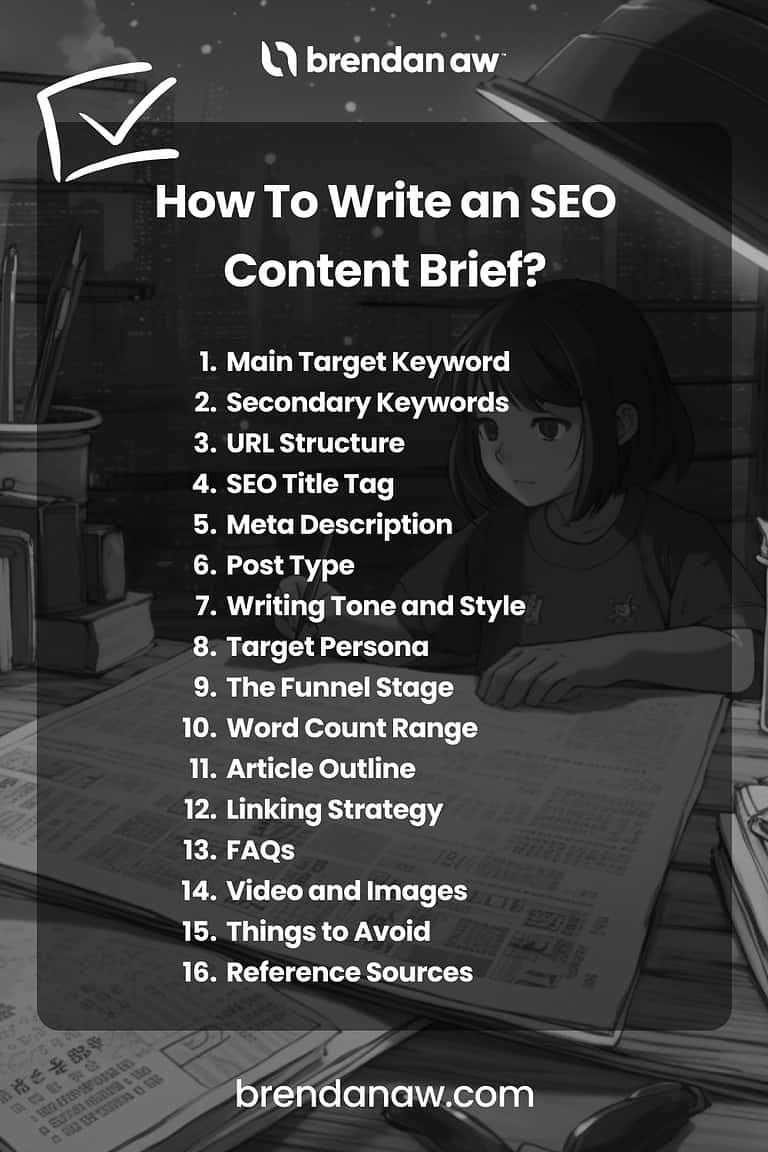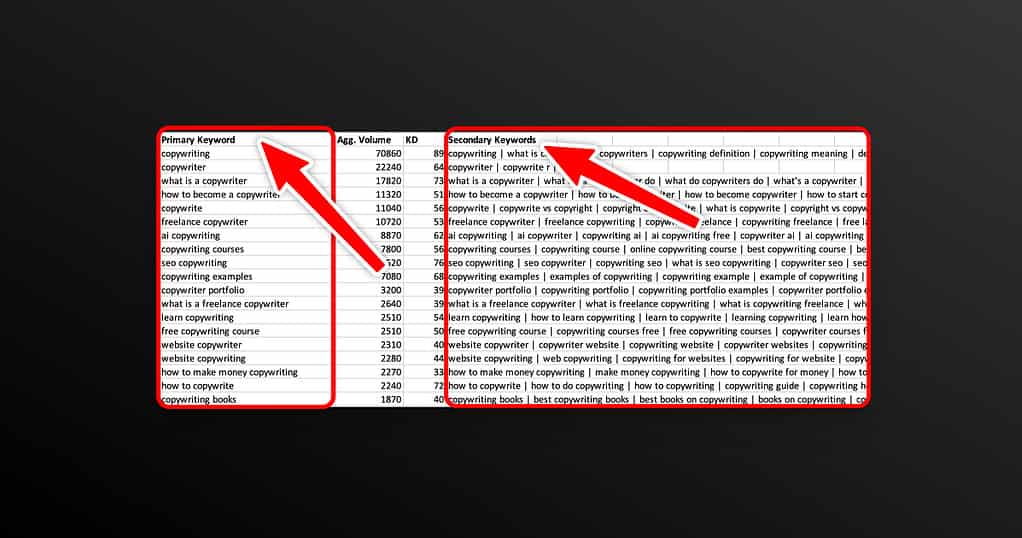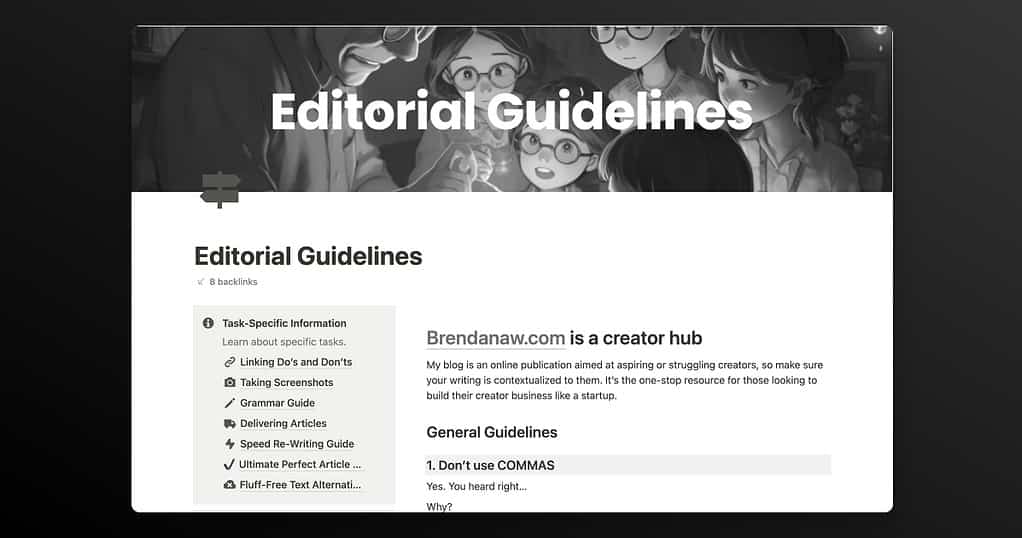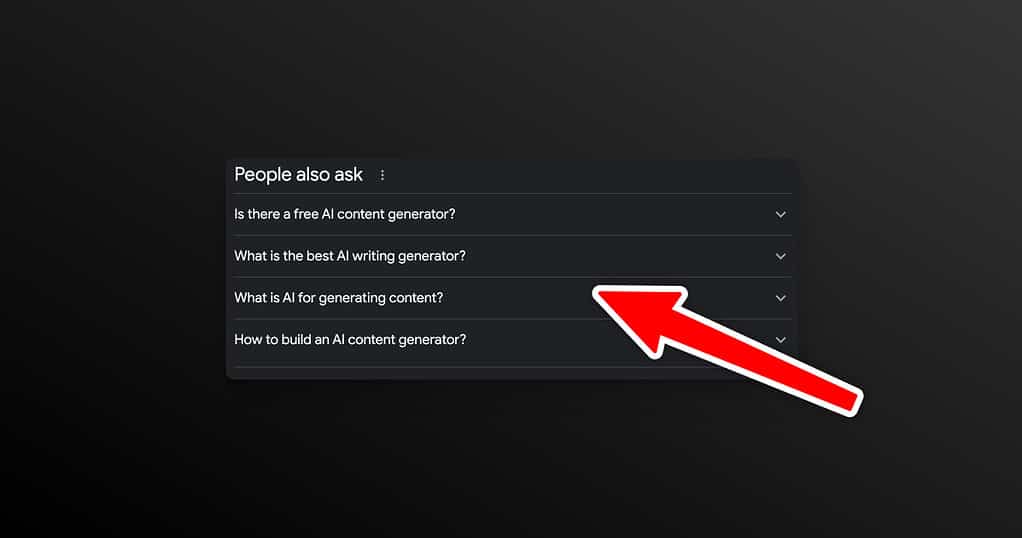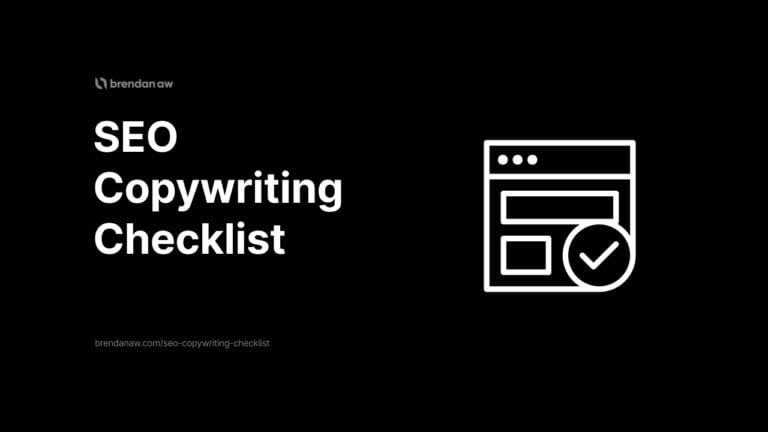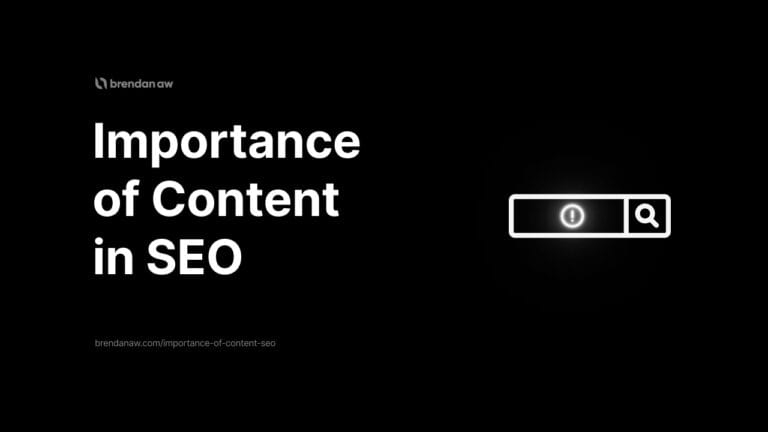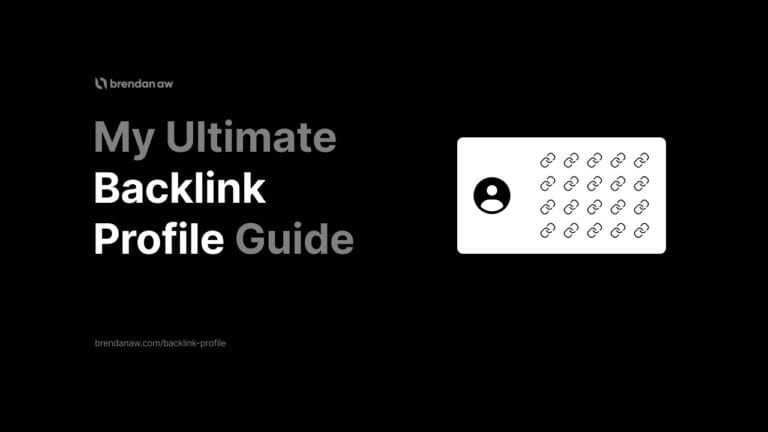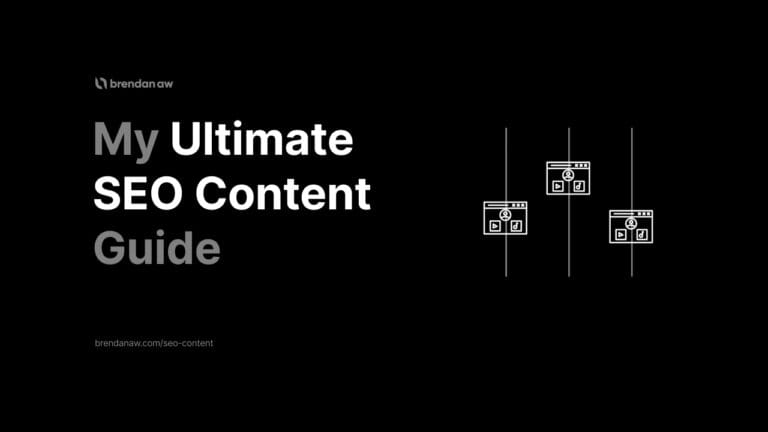Creating high-quality or updating SEO content for your website is not that difficult.
But what if you are outsourcing the task?
That’s sh!t can get complicated fast…
Especially if you do it regularly, you’ll waste a lot of time re-checking and revising weak content.
Your writers might be talented, but I’ll tell you a secret…
They AREN’T required to be proficient in SEO. That’s a bonus.
So manage your expectations if you want to achieve the best results.
How to ensure consistency and optimized articles?
Give them a damn SEO content brief.
Couple that with some solid Standard Operating Procedures (SOPs)…
And you have a powerhouse content production machine.
Now let me guide you.
What Is an SEO Content Brief?
An SEO content brief is a detailed outline that helps all stakeholders understand the content purpose and details of a target project.
It’s a checklist that includes items like:
- Company Overview
- Voice and tone
- Target audience
- Meta details
- URL structure
- Require keywords
- Internal and external links
- Word count
- Search intent
I won’t name all. Else we’ll be here till tomorrow.
It is a handy tool for guiding my team – from the writers, designers, and everyone else involved.
I don’t need to worry about consistency and quality because the documentation is clear, with no room for confusion.
It helps everyone be on the same page.
SEO content brief formats can vary, but the idea is the same.
Be as detailed as possible.
Why You Need an SEO Brief
You need an SEO brief if you want your pages to rank fast without constant revisions.
You have to produce high-quality, SEO-optimized content consistently.
Here’s how it can help you.
Cut Production Time
Do you usually go back and forth with your writers when finalizing drafts?
It can be frustrating, especially if there are no clear guidelines.
This will save you and your team a lot of effort, money, and time.
With clear-cut instructions and requirements, everyone can easily fulfill their objectives.
Brings Consistency
Every stakeholder or writer you work with has their style, idea, and belief of what an SEO-optimized article should be.
Or none at all.
But if you want your pages to rank, you need to publish quality content regularly.
An SEO content brief will do just that.
Everyone will always have standard guidelines to follow to a T, no matter who they are.
Improve Rankings
You’ll also increase the chances of gaining more impressions and ranking higher in SERP.
Everyone can check every essential item off an SEO checklist more efficiently.
This ensures each piece you publish qualifies to be on page 1 of Google SERPs.
It has helped me maintain consistency with my blog’s SEO even if I’m not directly involved with the writing.
Who Should Use SEO Content Briefs?
Anyone who wants to sustain quality and consistency in creating content should use a content brief for SEO.
You can churn out more high-performing content in less time.
Everyone directly or indirectly involved with that content piece should have access to the brief.
This can include marketers, writers, proofreaders, editors, web developers, and designers.
This ensures that the quality of work is maintained throughout the process.
An SEO content brief is still useful, even if you’re just a one-man team.
It keeps you organized.
In a nutshell, here are those who should use them:
- Marketing Strategists
- Editors
- Writers
- SEO managers
- Content Managers
- Proofreaders
- Web Developers
- Web Designers
How to Write an SEO Content Brief
When creating a brief, you should know what your target readers want.
You can cover all the SEO essentials that way.
Everything should be well-structured. Well-organized. Easy to understand.
Directions should be clear and concise.
Here’s what should be included in an SEO-Content Brief.
- Main Target Keyword
- Secondary Keywords
- URL Structure
- SEO Title Tag
- Meta Description
- Post Type
- Writing Tone and Style
- Target Persona
- The Funnel Stage
- Word Count Range
- Article Outline
- Linking Strategy
- FAQs (Frequently Asked Questions)
- Video and Images
- Things to Avoid
- Reference Sources
1) Main Target Keyword
This should be the very first item to include because every article should be optimized around only ONE main target keyword.
I’ve seen so many websites get this completely wrong.
This single item will dictate everything else that follows.
Once you’ve conducted keyword research, identify and indicate the primary keyword before the main outline.
This would appear in the main title and other headings, so it’s important to highlight it.
The next step is to include secondary keywords (if there are any).
2) Secondary Keywords
I don’t see this being included nearly as often.
All articles don’t just rank for the main target keyword. They can rank for hundreds if not thousands.
The manual way of doing this is by looking at other relevant medium-tail queries on:
- People also ask
- Related searches
- Forums
- Competing articles
But here’s a better way:
- Export all the keywords for a seed term from Semrush, Ahrefs or any other keyword research tool
- Run the CSV file through a keyword clustering tool
- Get the main keyword and supporting secondary keywords already laid out
Here’s what the clustered CSV file will look like.
3) URL Structure
The words following your root domain URL should ALWAYS be the same as your main target keyword.
And each word should be separated by a dash “-” not an underscore “_” as Google web crawlers don’t like weird characters.
Also, try not to include any numbers in it.
Look at the URL for this article.
Target keyword: SEO Content Brief
URL structure: https://brendanaw.com/seo-content-brief
4) SEO Title Tag
A compelling title is able to convince readers to click on your page.
Create a title tag relevant to your target users’ search intent.
It should contain the main target keyword you want to rank for.
Set some general directions. But be flexible and give your writer creative freedom in creating an engaging hook.
The important thing is that it should be SEO-driven.
5) Meta Description
This is not a priority, as Google tends to rewrite them.
But it does help with click-through rates if it’s a compelling hook.
It’s also a great spot to add the main target or a secondary keyword.
6) Post Type
Another important factor that many get wrong.
Figuring out the format boils down to understanding the search intent of the target keyword.
If I typed “best ai content generator” in Google. Notice how all the top articles are roundup reviews.
This clearly indicates that both Google and searchers want this type of article.
Try to deviate from this, and you’ll not rank.
Examples of common article formats:
- How-to’s
- Roundup reviews
- Listicles
- Explanatory articles
- Individual product reviews
- Case studies
- Versus posts
Always look at the highest-ranking pages for the target keyword to figure this out.
7) Writing Tone and Style
How do you want to speak to your customers?
Do you want to sound like a friend giving advice or a professor? Determine whether the tone is conversational or a little bit more distanced.
Indicate whether the writing is in the first, second, or third voice.
This part should also contain editorial standards for grammar, spelling, and capitalization.
Note your preferred citation preferences. APA, Chicago, etc.
Your writing style is part of your brand identity.
And it becomes a unique differentiator that helps set your product apart.
Let the writer know this.
But I’d like to go one step further and link them to my editorial guidelines.
8) Target Persona
The target persona guides your writers in creating content that resonates with intended readers.
Let’s say your website is about a B2B service, but your writers seem to address individual consumers.
That’s a disconnect.
Giving precise instructions on who to write for will help the content reach its objective.
Content without a clear target persona is weak and confusing.
Identify who you want to write for early on.
9) The Funnel Stage
Identifying the funnel stage your readers are in determines the type of content that will best resonate.
It gives the article a clear goal. To drive the reader down the funnel.
For example, if your writer puts too many CTAs in a topic for readers in the awareness stage might sound too sale-sy.
It won’t work as well as it should.
On the other hand, writers might miss the opportunity to convert if they are not writing strategically for readers who are already ready to buy.
Your writers must clearly understand this before they start to write.
10) Word Count Range
A fixed word count is not a direct ranking factor but indirectly tells you how comprehensive the article should be.
And this is derived by analyzing the top articles on page 1.
I tend to either:
- Take an average of the top 3 articles
- Write 200-300 words above the top article
I also prefer giving a range so my writers have some breathing room.
You should also allocate the number of words for each section so they know where to focus.
11) Article Outline
Having clear, structured outlines makes your writers’ work much easier.
The writing and research process will be faster as the main headers are clearly defined.
You could put general guidelines, but I recommend being as detailed as possible. Leave nothing up to interpretation.
A basic SEO content brief outline would have:
- A main title (usually containing the primary keyword)
- An introduction
- Topics and sub-topics
- Headings and subheadings (H1, H2, H3)
- Additional sections
- Conclusion
Those are the common parts of the outline, but you could be as detailed as you like.
Here are some more things to add:
- Key takeaways per topic/section
- Tips for potential sources (a great help)
- Background research
An outline that’s too rigid may be stifling to the writer. This can result in unnatural-sounding content that obviously wants to meet SEO requirements.
However, if a writer is not an expert on the topic, you may need to hold their hand by giving them something more thorough.
12) Linking Strategy
Having a linking strategy is a crucial SEO best practice.
You shouldn’t overlook putting this in the brief.
Choose relevant pages within your site to include as internal links, as this help give more context to the article.
External links should be used when citing data, studies, and statistics. These should be from credible and authoritative sources only.
Web crawlers and your readers will love this.
13) FAQs (Frequently Asked Questions)
FAQs allow your content to target current popular queries that don’t fit in the main content body.
Get a list of questions by looking at “People Also Asked” section in Google or searching for common long-tail question keywords.
You could look at which questions are used by competing articles too.
14) Video and Images
Some content briefs contain instructions on how to gather videos and images.
Let writers (or anyone in charge) know what to do by specifying if any required file formats or image sizes exist.
As part of SEO best practice, writers should optimize audio-visual media by adding descriptions and alt texts.
Proper source attributions should also be made.
15) Things to Avoid
Mention if certain things should be avoided in the content.
Typically, this includes reminding the writer that some topics are off-limits. These pertain to political, racial, or religious matters.
Controversial issues should be best left unmentioned.
Some brand partners sometimes want to stay in the background, so remind the writer not to bring them up.
Also, you may want to avoid mentioning competitor brands.
Other things to avoid are certain stylistic and grammatical choices and some words.
16) Reference Sources
You can add a list of potential sources to supplement the writer’s research.
While it’s the writer’s job to do research, there’s no harm in pointing in the right direction.
These should be limited to primary sources. These included published studies, data and statistics, and expert quotes.
You could also insert the top content that stood out while crafting the brief.
What is the Difference Between an SEO Content Brief and a Content Brief?
A Content Brief is a Blueprint for Writing Projects
A content brief is a piece of document that helps keep writing projects on track.
Content briefs generally contain key instructions such as a rough outline, the word count, the style and tone, visual elements, and the titles and subheadings.
It can go deeper and provide more exhaustive information. These include main objectives, background research, and more.
Content briefs should be structured. It shouldn’t look like random points that you’ve scribbled down somewhere.
The goal is to make everything clear, concise, and understandable.
They are usually created using shareable documents for easy collaboration.
An SEO Content Brief is for Ranking Performance
SEO content briefs are all of the above too.
The obvious difference is that the SEO content briefs are created to improve search engine performance.
These will include items like:
- Search intent
- Link strategy
- Semantic keywords
- Aggregated word count
- Keyword density
An SEO Content Brief Highlights Keywords
Content briefs for SEO contain instructions on which keywords to use. Some indicate where to insert them.
Other types of instructions include how to optimize headings and subheadings.
Like a regular content brief, an SEO-focused one streamlines the content production process.
It also ensures that SEO standards are met.
This way, writers can efficiently produce output that has a higher potential to rank.
SEO Content Brief Template
Here’s a rough example to give you a better idea of what an SEO content brief looks like.
Example: An article about collecting plants
Meta Information
URL Structure: www.yourwebsite.com/how-to-collect-plants
Suggested Title: How to Collect Plants: 5 Steps for Beginners
Meta Description: Trying to develop a green thumb and add some flora to your collection? In this article, I’ll show exactly how to collect plants in 5 steps.
Keyword Information and SERP Analysis
Primary Keyword: How To Collect Plants
Secondary Keywords:
- Plant collection guide
- Tutorial on collecting plants
- Steps to collect plants
- Tips on collecting plants
Search Intent: A step-by-step How-to guide
Target Persona: Beginner plant collectors
Competing Articles:
- www.sdnhm.org/science/botany/resources/general-information/how-to-make-a-plant-collection
- www.uaf.edu/museum/collections/herb/projects/reports/instructions-for-plant-co/
- www.rbgsyd.nsw.gov.au/getmedia/36d07669-629a-45c1-b39a-66b5961dca48/How-to-collect-plants.pdf
Word Count: 1,400 to 1,500 words
Funnel Stage: Top of the Funnel – Awareness Stage
Writing Guidelines
General Expectations:
- No fluff
- Use short sentences
- Reduce commas
- No conjunctive adverbs
- Use bullet lists when possible
- Insert an image in each step
Style & Tone: Conversational, first-person
Internal Links:
- www.yourwebsite.com/rarest-plants
- www.yourwebsite.com/how-to-maintain-a-plant-collection
- www.yourwebsite.com/best-planting-tools
Article Outline
Intro
- 50-100 words
- Include short anecdote
- Use AIDA copywriting formula
- Briefly answer the search intent: “Why is it good to collect plants”
Why Should You Collect Plants (H2)
- 150-200 words
- Expound on your answer in the intro
- Cite sources and studies
- Use external links
How To Start Collecting Plants (H2)
- 400-500 words
- Insert links from existing articles in the site
- Include 5 steps for collecting plants (each step in H3)
Tips for Collecting Plants
- 200-300 words
- A bulleted list of your top tips
Frequent Ask Questions
- 200-300 words
- Search People also ask, related searches and forums
Conclusion
- 50-100 words
- Summarize the article
Images
- JPG images (1200×630 pixels)
- Cite the image source and create a caption with alt text
An SEO content brief looks something like the one above.
But this is just a rough guide.
Start with this but refine it over time.
SEO Content Brief (FAQs)
How Do You Structure an SEO Content Brief?
The number one consideration for structuring an SEO content brief is readability.
But there are different ways to structure an SEO Content Brief.
One, you could structure it using enumerated and bulleted lists.
A table would also work well in organizing the details. You could add charts, screenshots, or graphics to be more comprehensive.
Personally, I like using the enumerated format and expanding them with key takeaways.
How Long Should an SEO Content Brief Be?
The length of the content brief for SEO depends on several factors.
First, it depends on the total word count of the material.
The higher the word count, the more topics and subtopics to be covered.
Second, it depends on how much information you want to add.
You may want to add more comprehensive details such as the objectives, target personas, or background research.
In the end, it’s really up to you.
Can I Use an SEO Content Brief Generator?
Yes, you can use an SEO Content Brief Generator. It’s a good option if you’re pressed for time.
Aside from being time-efficient, it also has many other SEO-related benefits.
Nowadays, Content brief generators are powered by AI to provide valuable data-driven insights.
Some generators have built-in competitor analysis and keyword research features. These would come in handy.
Of course, it’s still best to double-check and verify everything, especially when data is involved.
AI generators are not fail-proof.
An SEO content brief still needs a human touch.
What Is the Role of the Content Brief for SEO?
The role of the content brief of SEO is to streamline content creation while ensuring consistent quality production.
You get to enjoy both quantity and quality for the whole process.
The more consistently you generate optimized material, the more chances you can get into the top pages.
Using a brief also becomes essential if you want your team to produce SEO articles daily or multiple times a week.
With the help of precise instructions to your writers, each piece of content will meet the right standards.
In the end, you get the sustained traffic and engagement that you want.
It just makes work easy for everyone.
Why Is Content Length Important When Writing an SEO-Focused Content Brief?
Content length strikes a balance between on-page SEO criteria and topic depth. It’s not a direct Google ranking factor but it gives you a good idea of how detailed you must be based on the word count of top articles.
This ensures you answer the searcher’s query optimally or better.
What Are Some Common Mistakes To Avoid When Writing a Content Brief?
Some of the common mistakes are:
• Too rigid briefs
• No outlines
• Doing all the research for the writer
• Not profiling the target audience
• Not linking to editorial guidelines
How Does Competitive Analysis Fit Into an SEO Content Brief?
Conducting a competitive analysis helps you identify the exact on-page elements of competing articles so you know how comprehensive your article needs to be.
To Sum Up
An SEO content brief is a powerful tool to have in your arsenal.
It’s extremely helpful in streamlining workflow. You’ll enjoy a much more efficient content production process.
No more back and forth with writers or other stakeholders.
Good use of SEO briefs will make your content extra potent.
Your content will have clear objectives and resonate strongly with target readers.
Don’t forget to finish with a blog post checklist for that last line of defense.
Alright, that’s all.
Get those articles ranking!
Please help share and comment below if this helped you.


